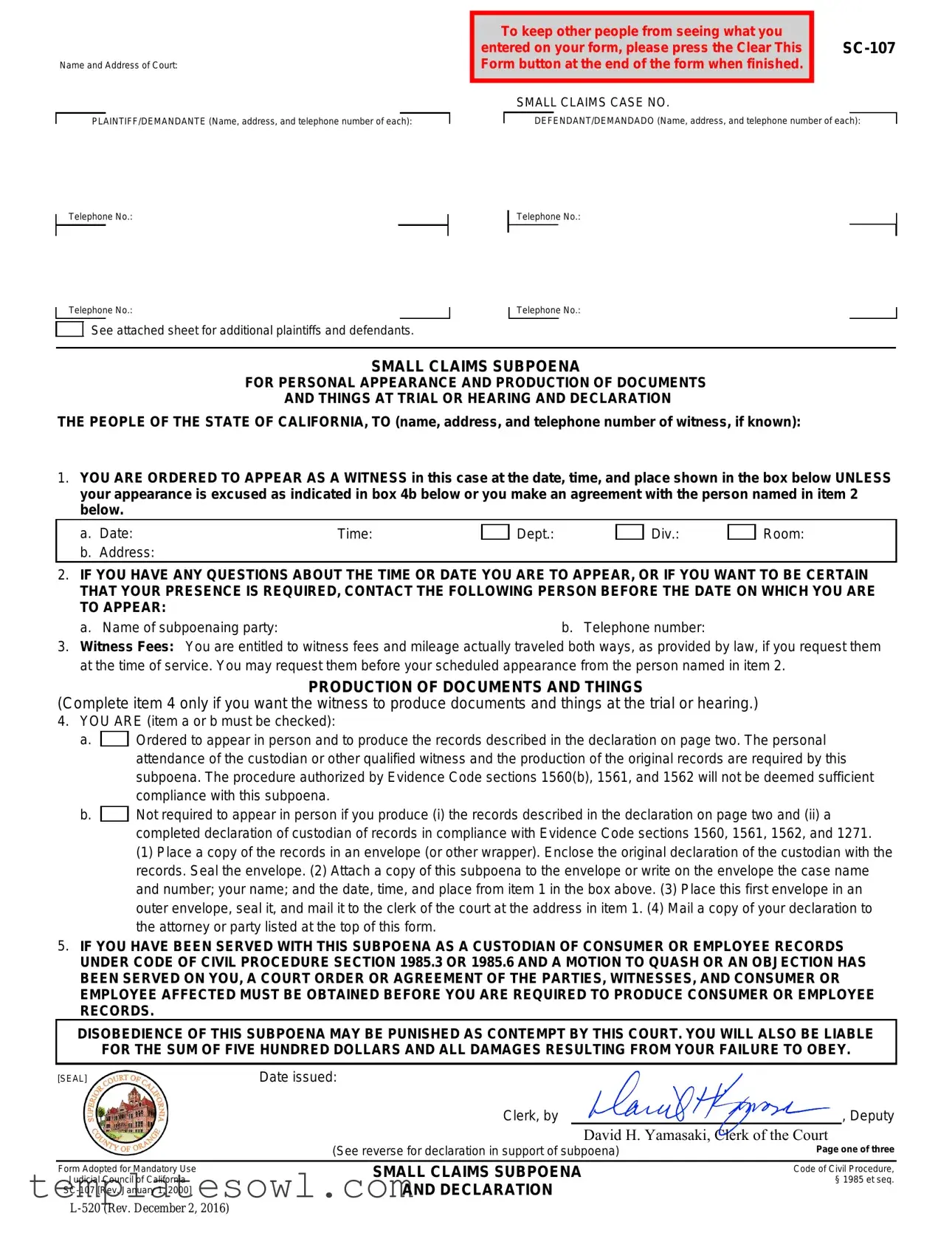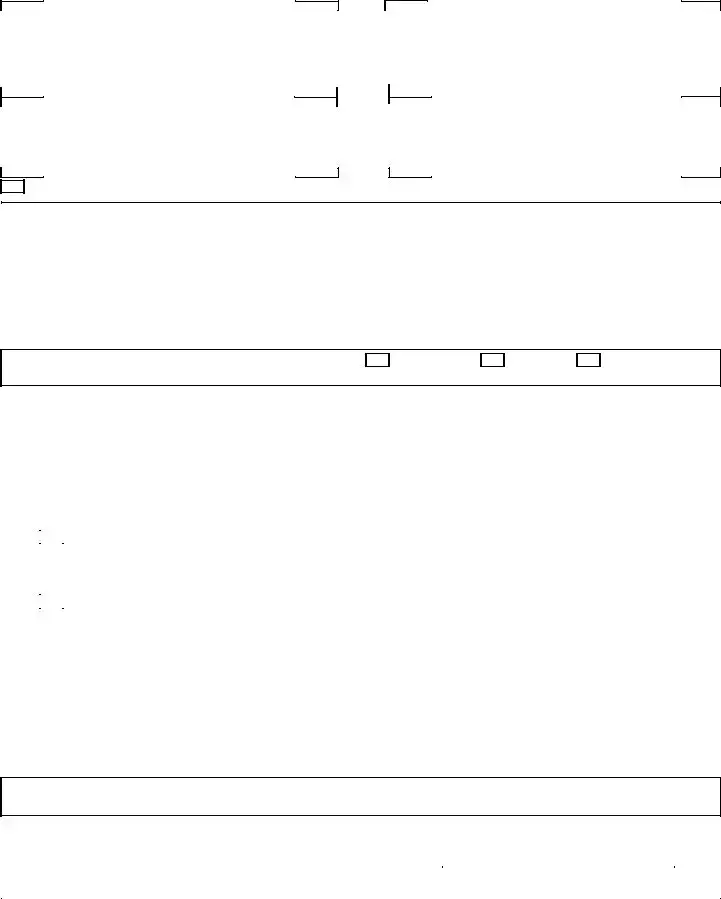Name and Address of Court:
PLAINTIFF/DEMANDANTE (Name, address, and telephone number of each):
Telephone No.:
Telephone No.:
See attached sheet for additional plaintiffs and defendants.
To keep other people from seeing what you |
SC-107 |
entered on your form, please press the Clear This |
Form button at the end of the form when finished. |
|
|
|
SMALL CLAIMS CASE NO.
DEFENDANT/DEMANDADO (Name, address, and telephone number of each):
Telephone No.:
Telephone No.:
SMALL CLAIMS SUBPOENA
FOR PERSONAL APPEARANCE AND PRODUCTION OF DOCUMENTS
AND THINGS AT TRIAL OR HEARING AND DECLARATION
THE PEOPLE OF THE STATE OF CALIFORNIA, TO (name, address, and telephone number of witness, if known):
1.YOU ARE ORDERED TO APPEAR AS A WITNESS in this case at the date, time, and place shown in the box below UNLESS your appearance is excused as indicated in box 4b below or you make an agreement with the person named in item 2 below.
a. |
Date: |
Time: |
b. |
Address: |
|
2.IF YOU HAVE ANY QUESTIONS ABOUT THE TIME OR DATE YOU ARE TO APPEAR, OR IF YOU WANT TO BE CERTAIN THAT YOUR PRESENCE IS REQUIRED, CONTACT THE FOLLOWING PERSON BEFORE THE DATE ON WHICH YOU ARE TO APPEAR:
a. Name of subpoenaing party: |
b. Telephone number: |
3.Witness Fees: You are entitled to witness fees and mileage actually traveled both ways, as provided by law, if you request them at the time of service. You may request them before your scheduled appearance from the person named in item 2.
PRODUCTION OF DOCUMENTS AND THINGS
(Complete item 4 only if you want the witness to produce documents and things at the trial or hearing.)
4.YOU ARE (item a or b must be checked):
a. |
|
Ordered to appear in person and to produce the records described in the declaration on page two. The personal |
|
|
attendance of the custodian or other qualified witness and the production of the original records are required by this |
|
|
subpoena. The procedure authorized by Evidence Code sections 1560(b), 1561, and 1562 will not be deemed sufficient |
|
|
compliance with this subpoena. |
b. |
|
Not required to appear in person if you produce (i) the records described in the declaration on page two and (ii) a |
|
|
completed declaration of custodian of records in compliance with Evidence Code sections 1560, 1561, 1562, and 1271. |
(1)Place a copy of the records in an envelope (or other wrapper). Enclose the original declaration of the custodian with the records. Seal the envelope. (2) Attach a copy of this subpoena to the envelope or write on the envelope the case name and number; your name; and the date, time, and place from item 1 in the box above. (3) Place this first envelope in an outer envelope, seal it, and mail it to the clerk of the court at the address in item 1. (4) Mail a copy of your declaration to the attorney or party listed at the top of this form.
5.IF YOU HAVE BEEN SERVED WITH THIS SUBPOENA AS A CUSTODIAN OF CONSUMER OR EMPLOYEE RECORDS UNDER CODE OF CIVIL PROCEDURE SECTION 1985.3 OR 1985.6 AND A MOTION TO QUASH OR AN OBJECTION HAS BEEN SERVED ON YOU, A COURT ORDER OR AGREEMENT OF THE PARTIES, WITNESSES, AND CONSUMER OR EMPLOYEE AFFECTED MUST BE OBTAINED BEFORE YOU ARE REQUIRED TO PRODUCE CONSUMER OR EMPLOYEE RECORDS.
DISOBEDIENCE OF THIS SUBPOENA MAY BE PUNISHED AS CONTEMPT BY THIS COURT. YOU WILL ALSO BE LIABLE
FOR THE SUM OF FIVE HUNDRED DOLLARS AND ALL DAMAGES RESULTING FROM YOUR FAILURE TO OBEY.
|
[SEAL] |
Date issued: |
|
|
|
|
Clerk, by |
|
|
, Deputy |
|
|
|
David H. Yamasaki, Clerk of the Court |
|
|
(See reverse for declaration in support of subpoena) |
Page one of three |
|
Form Adopted for Mandatory Use |
SMALL CLAIMS SUBPOENA |
Code of Civil Procedure, |
|
Judicial Council of California |
§ 1985 et seq. |
|
AND DECLARATION |
|
SC-107 [Rev. January 1, 2000] |
|
|
L-520 (Rev. December 2, 2016)
PLAINTIFF/PETITIONER:
DEFENDANT/RESPONDENT:
DECLARATION IN SUPPORT OF
SMALL CLAIMS SUBPOENA FOR PERSONAL APPEARANCE
AND PRODUCTION OF DOCUMENT AND THINGS AT TRIAL OR HEARING
(Code Civil Procedure sections 1985, 1987.5)
1. I, the undersigned, declare I am the
other (specify):
judgment creditor
in the above entitled action.
2. The witness has possession or control of the following documents or other things and shall produce them at the time and place specified on the Small Claims Subpoena on the first page of this form.
For trial or hearing (specify the exact documents or other things to be produced by the witness):
Continued on Attachment 2a.
After trial to enforce a judgment (specify the exact documents or other things to be produced by the party who is the judgment debtor or other witness possessing records relating to the judgment debtor):
(1) |
|
Payroll receipts, stubs, and other records concerning employment of the party. Receipts, invoices, documents, |
|
|
and other papers or records concerning any and all accounts receivable of the party. |
(2) |
|
Bank account statements, canceled checks, and check registers from any and all bank accounts in which the party |
|
|
|
has an interest. |
(3) |
|
Savings account passbooks and statements, savings and loan account passbooks and statements, and credit |
|
|
|
union share account passbooks and statements of the party. |
(4) |
|
Stock certificates, bonds, money market certificates, and any other records, documents, or papers concerning all |
|
|
|
investments of the party. |
(5) |
|
California registration certificates and ownership certificates for all vehicles registered to the party. |
|
(6) |
|
Deeds to any and all real property owned or being purchased by the party. |
|
(7) |
|
Other (specify): |
|
3. Good cause exists for the production of the documents or other things described in paragraph 2 for the following reasons:
Continued on Attachment 3.
4. These documents are material to the issues involved in this case for the following reasons:
Continued on Attachment 4.
I declare under penalty of perjury under the laws of the State of California that the foregoing is true and correct.
Date:
. . . . . . . . . . . . . . . . . . . . . . . . . . . . . . . . . . . . . . . . . . . . .
(TYPE OR PRINT NAME) |
(SIGNATURE OF PARTY) |
(See proof of service on page three)
SC-107 [Rev. January 1, 2000]
SMALL CLAIMS SUBPOENA
AND DECLARATION
PLAINTIFF/PETITIONER:
DEFENDANT/RESPONDENT:
PROOF OF SERVICE OF SMALL CLAIMS SUBPOENA FOR PERSONAL APPEARANCE
AND PRODUCTION OF DOCUMENTS AND THINGS AT TRIAL OR HEARING
AND DECLARATION
1.I served this Small Claims Subpoena for Personal Appearance and Production of Documents and Things at Trial or Hearing and Declaration by personally delivering a copy to the person served as follows:
a.Person served (name):
b.Address where served:
c.Date of delivery:
d.Time of delivery:
e.Witness fees (check one):
(1) |
|
were offered or demanded |
|
|
and paid. Amount: . . . . . $ |
(2) |
|
were not demanded or paid. |
f.Fee for service: . . . . . . . . . . . . . . . $
2.I received this subpoena for service on (date):
3.Person serving:
a. |
|
Not a registered California process server. |
|
|
|
b. |
|
California sheriff, marshal, or constable. |
|
|
|
c. |
|
Registered California process server. |
|
|
|
d. |
|
Employee or independent contractor of a registered California process server. |
|
|
|
e. |
|
Exempt from registration under Business & Professions Code section 22350(b). |
|
|
|
f. |
|
Registered professional photocopier. |
|
|
|
g. |
|
Exempt from registration under Business & Professions Code section 22451. |
h. Name, address, and telephone number and, if applicable, county of registration and number:
I declare under penalty of perjury under the laws of the State |
(For California sheriff, marshal, or constable use only) |
of California that the foregoing is true and correct. |
I certify that the foregoing is true and correct. |
Date: |
Date: |
SC-107 [Rev. January 1, 2000]
PROOF OF SERVICE OF SMALL CLAIMS SUBPOENA
FOR PERSONAL APPEARANCE AND PRODUCTION OF DOCUMENTS
AT TRIAL OF HEARING AND DECLARATION
For your protection and privacy, please press the Clear This
Form button after you have printed the form.



